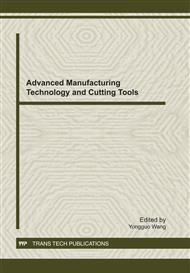[1]
E. Brinksmeier, A. Walter, R. Janssen and P. Diersen: Proceedings of the Institution of Mechanical Engineers Part B-Journal of Engineering Manufacture Vol. 213 (1999), pp.769-778.
DOI: 10.1243/0954405991517209
Google Scholar
[2]
S.N. Murphy, M.M. Morgan, G.O. Barnett and H.C. Chueh: Journal of the American Medical Informatics Association (1999), pp.892-896.
Google Scholar
[3]
K. Weinert, I. Inasaki, J.W. Sutherland and T. Wakabayashi: CIRP Annals-Manufacturing Technology Vol. 53 (2004), pp.511-537.
DOI: 10.1016/s0007-8506(07)60027-4
Google Scholar
[4]
B. Yin and R. Han: International Journal of Machine Tools and Manufacture Vol. 46 (2006), pp.623-630.
Google Scholar
[5]
Y.S. Liao and H.M. Lin: International Journal of Machine Tools & Manufacture Vol. 47 (2007), pp.1660-1666.
Google Scholar
[6]
J.A.C. Alves, U.D. Fernandes, A.E. Diniz, E.C. Bianchi, P.R. de Aguiar and R.C. Canarim: Journal of the Brazilian Society of Mechanical Sciences and Engineering Vol. 31 (2009), pp.47-51.
Google Scholar
[7]
R.T. Xia: Advanced Materials Science and Technology Vol. 181-182 (2011), pp.1013-1017.
Google Scholar
[8]
S. Bhowmick, M.J. Lukitsch and A.T. Alpas: Journal of Materials Processing Technology Vol. 210 (2010), pp.2142-2153.
Google Scholar
[9]
L.C. Brandao, R.T. Coelho and A.T. Malavolta: Journal of the Brazilian Society of Mechanical Sciences and Engineering Vol. 32 (2010), pp.154-159.
Google Scholar
[10]
Y. Saikawa, T. Ichikawa, T. Aoyama and T. Takada: Key Engineering Materials Vol. 257-258 (2004), pp.559-564.
DOI: 10.4028/www.scientific.net/kem.257-258.559
Google Scholar
[11]
R.D. Han and B.L. Yin: Advances in Machining & Manufacturing Technology Viii Vol. 315-316 (2006), pp.51-55.
Google Scholar
[12]
C.Y. Zhang: Study on the Mechanism of MQL Cutting and Its Application Fundament (Ph.D. Dissertation, Jiangsu University, Zhenjiang, 2008. 4).
Google Scholar
[13]
Milton C. Shaw: Metal cutting principles (Oxford University Press, New York, 2005).
Google Scholar


